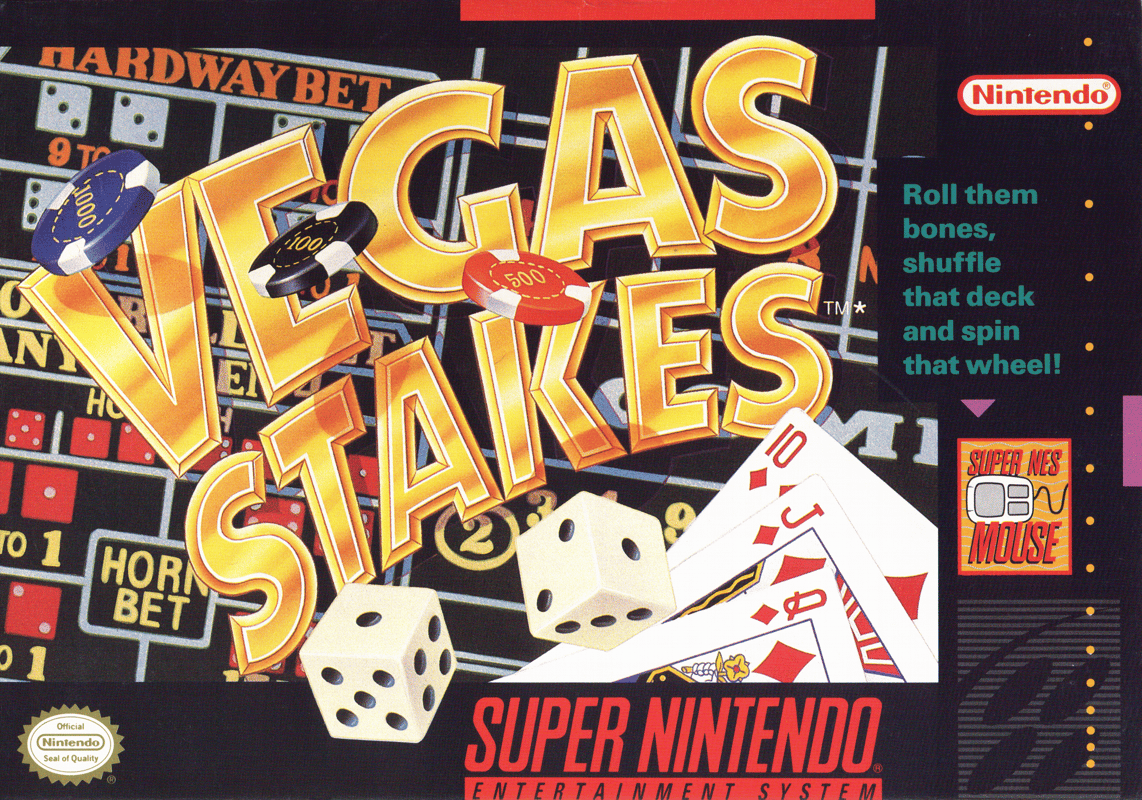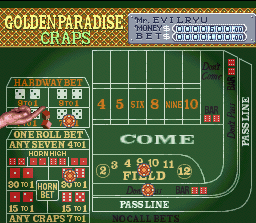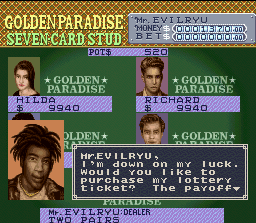- Retro XP
- Posts
- Retro spotlight: Vegas Stakes
Retro spotlight: Vegas Stakes
HAL followed up their NES trip to the strip with a more robust Super Nintendo sequel.
This column is “Retro spotlight,” which exists mostly so I can write about whatever game I feel like even if it doesn’t fit into one of the other topics you find in this newsletter. Previous entries in this series can be found through this link.
HAL Laboratory has basically been known The Kirby Studio for decades now, but they used to bounce all over the place in a different way. While HAL still varies their output — they just have Kirby star in whatever it is they want to make — there are parts of their past that they just don’t replicate or bring around in the present. Their series of casino games being one prominent example, to the point that, despite the second of them even being published by Nintendo in North America, it’s been buried deep enough to not appear on Nintendo Switch Online even after showing up on a couple of Virtual Consoles.
In 1988 for the Famicom and 1990 for the NES, HAL released Vegas Dream. You started off with $700 and a dream of winning $10 million, which you would do — or attempt to do, at least — by playing Keno, Roulette, Blackjack, and slot machines. There were randomized interactions with guests that could turn out well for you and your wallet or with you losing cash for one reason or another, casino workers, and even offers of marriage that could turn out to be legitimate or as part of a long con to get your money. The only real issue with it was the game selection: Keno, really? What are you, my mother?
In 1993, HAL released an SNES sequel to Vegas Dream that’s also the better known of the two: Vegas Stakes. While published by Nintendo in North America, don’t get the wrong idea: this was still during the era where HAL had some clear independence from the Big N, to the point that, in Japan, where it was known as Las Vegas Dream, it was published by Imagineer instead — it’s very much HAL’s game. Which also might be part of the reason that, like some other games from the era by HAL like HyperZone, Arcana, Trax, and HAL’s Hole in One Golf, Nintendo simply hasn’t bothered to re-release it in the current era, since it was either never their game at all or not really theirs, as in the case of Vegas Stakes. (At least Vegas Stakes did see Virtual Console releases, however.)

Image credit: MobyGames
In Vegas Stakes, you no longer get the marriage options, but the random interactions with strangers are still there, and you have a friend with you at all times whom you can ask for wager information or advice on a given game. They are more than just a piece of portrait art, too, as the quality of advice they give varies from game to game; you might find that you don’t want to listen to the one that constantly tells you to hit in Blackjack basically no matter the situation, or for the one who is always telling you to fold in poker unless your hand is already perfect. The wager information is the most useful bit of information, however, since it allows people who don’t already know things about, say, Roulette, to realize how the game is structured. You say you have 35-to-1 odds on a straight bet of a number, when there are 36 numbers on the wheel plus the zero and double-zero, neither of which counts as an even, odd, red, nor black in the side bets? And people play this game with the intention of winning money rather than losing it? Curious.
Roulette in Vegas Stakes is fine and all since it isn’t real money, and you can live the dream of actually winning a 35-to-1 odds bet, just don’t get any ideas about real life gambling here. Besides with craps, anyway — that’s the friendliest game in the house for real, and perfect if your goal is to just play and play and play without concerning yourself with actually turning $1,000 into $10 million. At least, not in a hurry. In Vegas Stakes, it’s the most significant addition, a massive upgrade on Keno, and a perfect place to learn about a game with layer upon layer of betting within it.
And hey, before you could just choose from among various digital craps games that cost $5 or whatever, or from a bunch of different apps on your phones, as part of a collection like this was the only way you’d get to play outside of driving to a casino. Craps over Keno made a ton of sense in more ways than one, especially if going for that authentic Vegas feel. The only thing it’s missing is a bunch of other players at the table all cheering on every dice roll or groaning in collective unison — except that one guy purposefully betting on seven and rooting for the rest of you to lose, no one likes that guy — but since Vegas Stakes does have multiplayer for everything besides poker, you can still pretend with the appropriate level of authenticity.

Image credit: MobyGames
Speaking of poker, it’s seven-card stud. Nearly forgotten about since Texas Hold ‘Em took over as the prominent poker game of the day in the past few decades, seven-card stud was an obvious pick for casino poker back in 1993 when Vegas Stakes released. You are dealt two cards face down and one face up, and betting proceeds from there, with an additional four cards dealt to each player who stays in the game rather than folding, one betting round at a time. You make the best five-card hand that you can out of the seven you receive, and rinse, repeat. Since your opponents could see your cards in a multiplayer scenario — and you’re competing against other people rather than the house, like in Blackjack — this one isn’t available for anything but solo mode.
There are five casinos in the game, four of which are available from the start. Though, you’re not going to want to dive into the higher end of those at first, given you need money to play in order to experience what they have on offer, anyway. The default is the Golden Paradise, where minimum bets are low — $20-25 depending on the game, $1 or $5 for slots — and maximum bets are also low, at $250 or $200 depending on the game, while slots let you go $25 or $50 per pull. If you lose your shirt, you can go to the rundown Hideaway, which has minimum bets of $1 even for the table games, and max bets of $50 for table games and $10 for poker, while slots top out at $25.
Buffalo Head is a western-themed casino (yee-haw!) with $50 minimums and $500 maximums, including for poker, and then there’s the futuristic, sci-fi-themed 2020 casino, which jumps to $100/$1,000, and lets you spend $500 per pull on the slot machines. Once you’ve amassed $100,000, you unlock the Laurel Palace, where you can either win a ton of money very, very quickly, or lose it even faster. That’s because the Laurel Palace has $1,000 minimum bets on everything besides the slot machines — which still require $50 for the lowest spin — and no limit betting as far as maximum bets go. This is where 35-to-1 payouts on roulette can sound real tempting, until, again, you remember there are 38 numbers on that wheel and the house has a built-in advantage over you. Still… imagine that payoff at the Laurel.
If you fall back under $100,000, your high-roller status is revoked by the Laurel Palace, and you’ll have to slum it up in the wild west or fake 2020. Unless you really lost almost everything, in which case the Hideaway awaits. If you do hit it big and win $10 million, one, congrats on your accomplishment, and two, I have some bad news for you: that’s a game over. You get a satisfying ending and all, but it’s also the end, truly. You don’t get the chance to just keep going with your save and blow it all at the Laurel on something irresponsible, but instead, if you want to keep playing, you have to start a new game with just $1,000 and a dream. It’s not the worst scenario by any means, but it does keep you from just casually messing around with any of the table games using the considerable resources that you’d built up to that point, freed from the narrative of the game.

Image credit: MobyGames
The randomized interactive events truly add something to the Vegas Stakes’ setup. The game would be perfectly fine without them, in the sense that it’s a place to play craps or Blackjack or seven-card stud or a video game slot machine that isn’t attached to gacha mechanics, but these events add a layer of complexity to the proceedings that are as gambling-based as the rest of the experience. Someone might be trying to pick your pocket, or they might be actually trying to help you out, and will give you a little something for trusting them. You won’t know until after you accept their pitch which it’s going to be — that guy wiping a spill off your shirt might be grabbing your wallet while he’s doing it, or he might actually just be doing you a favor with his handkerchief, and there’s only one way to find out.
You won’t know if that lottery ticket you’re buying from someone is a winner unless you play it, and if it is a winner, well it’s going to feel like it’s for a lot of money if you’re still at the Golden Paradise. That diamond might be made of glass and worth absolutely nothing, or you could talk a guy down from $5,000 to an $800 price on it and then turn around and sell it for $10,000 when someone walks by and admires it. Or you might buy someone’s watch from them for $200 since they lost all their money and need a way to get home, and then sell it for $1,000. Your friend finds a wallet, and you have the choice to return it to the office or keep it, keeping whatever is inside — if you do return it, there’s a chance that the owner of it will not only recover it, but then bet everything inside of it on their lucky number, then give you half of the winnings as thanks since it wouldn’t have been possible without your kindness. Or, they do that and lose it all in a different way, leaving you with nothing at all.
There are loads of these interactions, and they don’t occur unless you have $1,000 in your pocket. Which means that the Hideaway casino even has a secret one that only appears if you’re there when you aren’t supposed to be — why would you be in the Hideaway if you had $1,000? That’s for when you’re stuck betting $1 to try to work your way back up slowly. If you give this mystery woman a tip for serving you a beverage, she’ll give you a tip in return — the $5 slot machine in the Hideaway leans player-friendly, and is an easy way to try to get your bankroll back to Golden Paradise territory.
Vegas Stakes is one of 33 North American SNES games to support the SNES mouse — Super Caesars Palace, another casino game on the system published by Virgin Games, does as well. (Which game is better? Well, only one of them has craps, and the other has video poker rather than table poker.) You can play without the mouse just fine, of course, but everything involving bets on a craps table or for roulette moves faster with the mouse accessory, for sure, since you don’t have to cycle through options in the same way. Since it’s mouse compatible, you can also emulate this one on a computer with a mouse and have a similar experience by setting it as the input in the emulator, rather than a keyboard or game pad. The existence of mouse support makes it easy to hold out hope that Vegas Stakes will get a Nintendo Switch Online release in the Switch 2 era, given the Joy-Con mouse functionality, but again, since it didn’t actually need that to work, it’s unclear if this will happen — with the sheer volume of casino games available on the eShop, however, it’s the rare case where an NSO release would make more sense than a revival or paid re-release of some kind.
Unless HAL wants to make a casino game set in the Kirby universe, anyway. I would play Blackjack at a table where Waddle Doo is the dealer and all of the cards featured adorable Kirby-based artwork, and the other players at the poker table are citizens of Dream Land. I would pay money to do that, even.
This newsletter is free for anyone to read, but if you’d like to support my ability to continue writing, you can become a Patreon supporter, or donate to my Ko-fi to fund future game coverage at Retro XP.